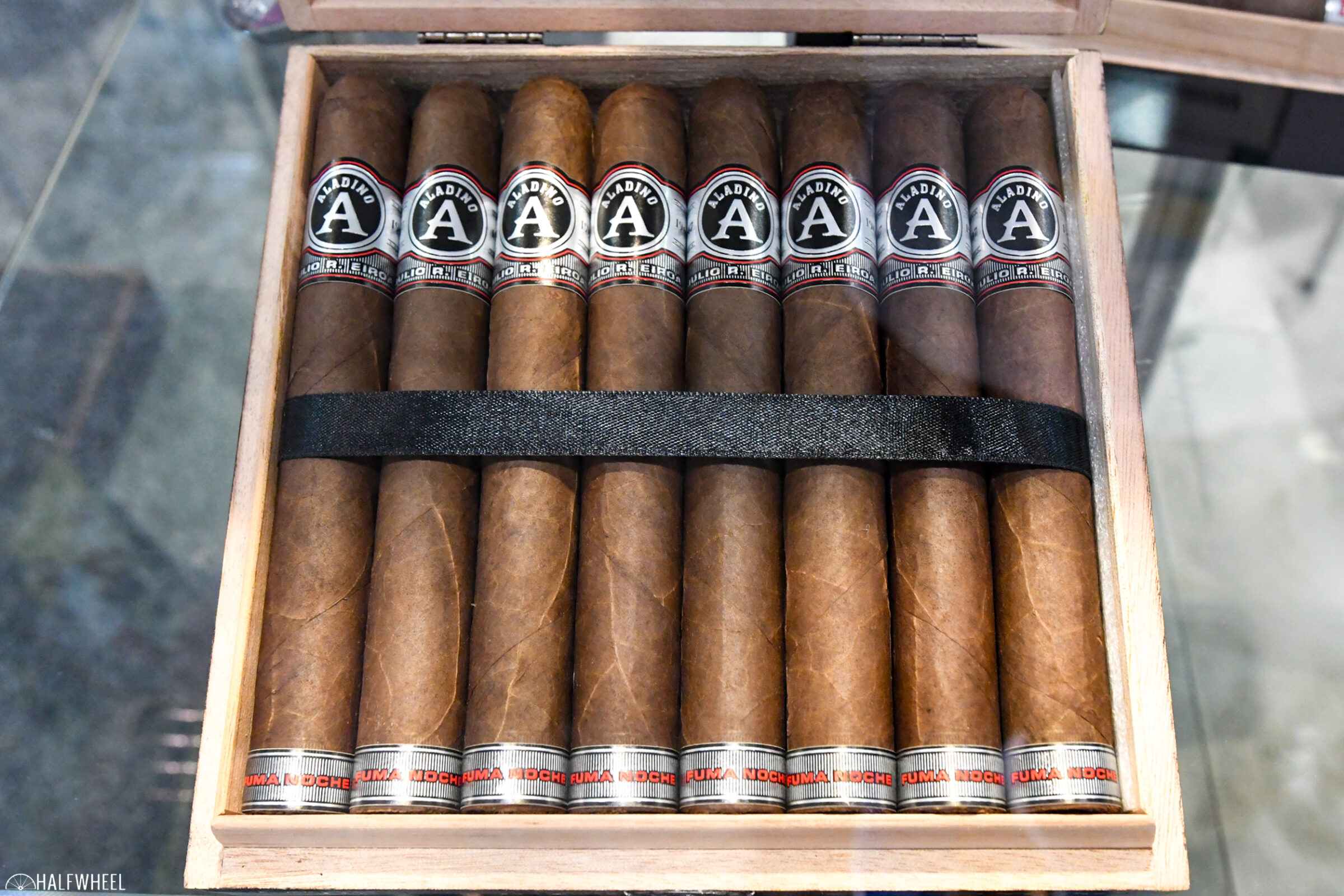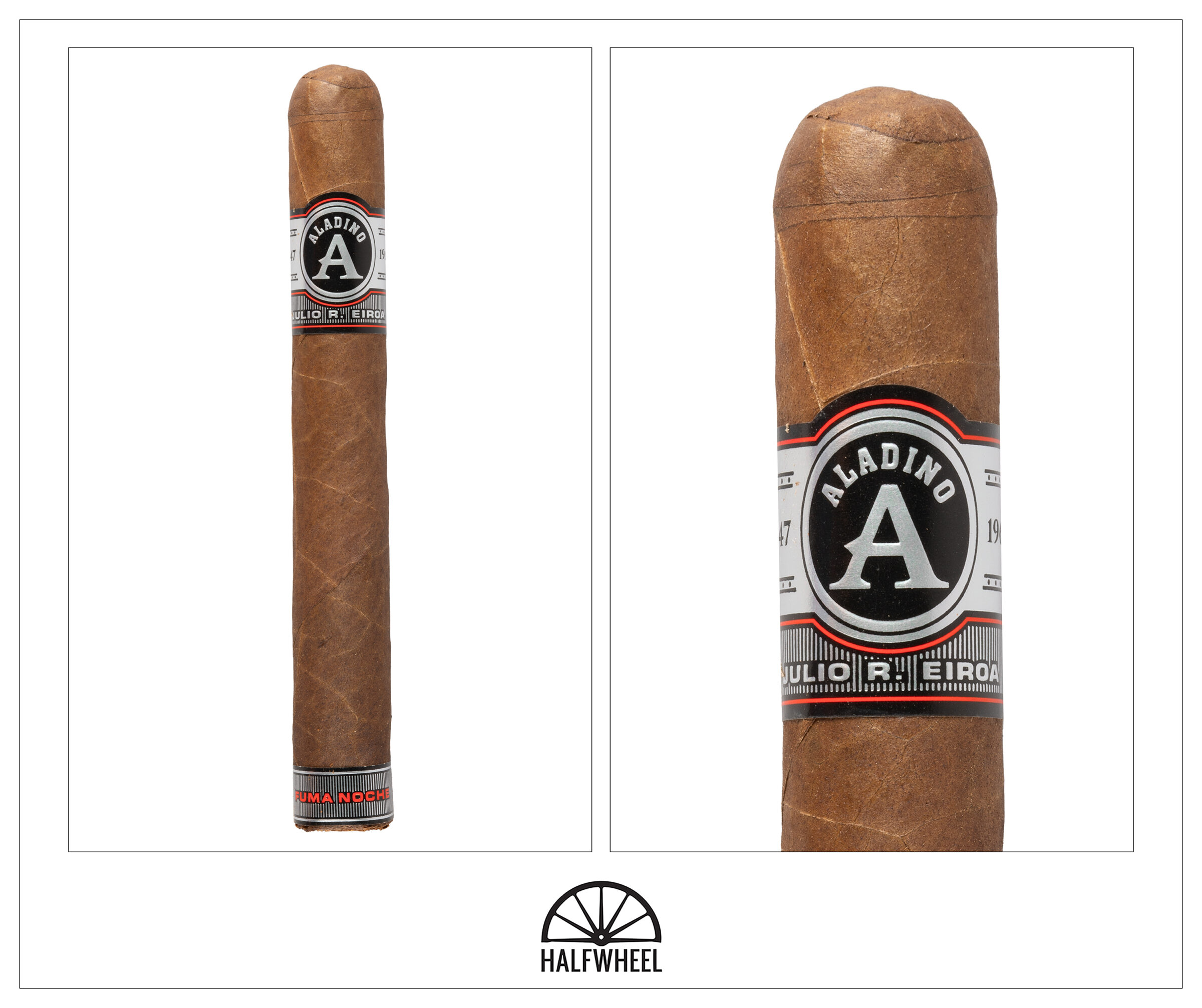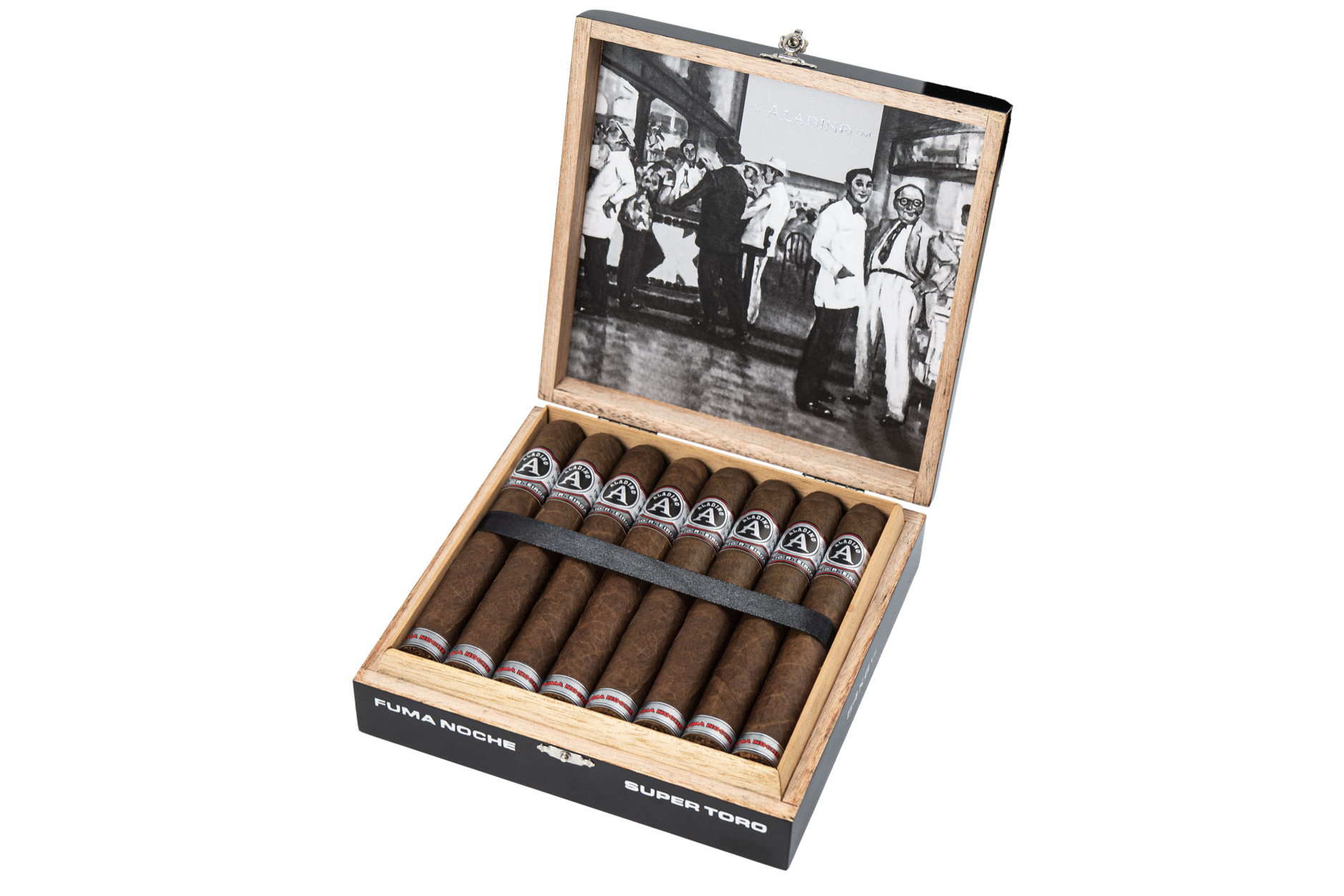Over the last couple of years, JRE Tobacco Co. has been introducing new blends in a somewhat deliberate way: releasing just one size at a time. For example, the Aladino Candela debuted in one size—though has since been offered in two more vitolas—last summer, the Aladino Limited Edition and Sumatra were introduced, each in a single 6 x 52 toro vitola.
In March, the company began shipping the Aladino Fuma Noche—offered in a single 6 1/4 x 54 toro extra vitola—while any day now, JRE is expected to ship the new Aladino Cameroon Reserva, which is launching in a single 6 x 52 vitola.
There is not a ton of background on Fuma Noche, Spanish for night cigar/smoke. The company says that it uses a maduro wrapper, though it’s not disclosing any other details about that wrapper, and said the binder and filler are grown on the Eiroa family’s farms in Honduras. Given the dark appearance and sinister-looking packaging, it should be of no surprise that the company describes this release as “full-bodied.”
- Cigar Reviewed: Aladino Fuma Noche Super Toro
- Country of Origin: Honduras
- Factory: Fábrica de Puros Aladino at Las Lomas Jamastran
- Wrapper: Undisclosed
- Binder: Honduras
- Filler: Honduras
- Length: 6 1/4 Inches
- Ring Gauge: 54
- Vitola: Toro Extra
- MSRP: $15 (Box of 16, $240)
- Release Date: March 2024
- Number of Cigars Released: Undisclosed
- Number of Cigars Smoked For Review: 3
For better or worse, the Aladino Fuma Noche Super Toro’s appearance isn’t all that unique. There’s a color that seems closer to the definition of medium brown than the darkness that seems to be used for “maduro” cigars these days, though those terms are remarkably subjective. Beyond the color, I see an average amount of oil and veins that are generally well-integrated, though some are accentuated by their lighter color. In terms of other features, outside of a foot band, it’s a pretty no-nonsense approach to what I expect from the appearance of a standard cigar. The aromas from the wrappers are medium-full. Even smelling the cigars side-by-side, I can’t find any differences between the first two: barnyard accented by smells of permanent markers, rocky minerals and some sweetness that reminds me of the smell of a box of raisins. The third cigar is pretty similar, though the raisin sweetness seems closer to a different kind of dried fruit, perhaps dried cranberries. The feet are also pretty similar, though I can’t detect much beyond the most generic cocoa smell and some hints of sweetness and ammonia, the latter of which is stronger in the third cigar. Cold draws are medium-full with the first cigar delivering creaminess, leather and black pepper over some semisweet cocoa, pear and a flavor that reminds me of Cracker Jack. The other two cigars are sweeter with a flavor that tastes like I just ate some Chips Ahoy! cookies and milk, joined with woodiness and generic fruitiness.
Sweet coffee, woodiness, sawdust, leather and saltiness are present during the third first puffs, though none of the cigars has all of those flavors. Within the first few puffs of the Aladino Fuma Noche Super Toro, it’s apparent this cigar is going to be drier than average, though I’m good with the overall flavor profile, especially the first cigar, which is excellent. There’s a mixture of nuttiness, blueberry sweetness and creaminess that leads green pepper and earthiness. The nuttiness—notably on the second and third cigars—is the strongest flavor, edging out the blueberry and creaminess. The finish is drier with remnants of creaminess, red wine, popcorn and some citrus. Retrohales tend to be led by peanuts over creaminess, leather and some beef broth. At times, there are some more unique flavors like cotton candy sweetness or leather, though the larger changes between the retrohales are the intensity and type of pepper. Sometimes it’s just a generic burn, other times, it reminds me of the spiciness of jalapeño peppers. That pepper reduces itself during the finish, which allows for tartness, dry bread and a mayonnaise-like savory creaminess flavor to emerge. All three cigars need to be puffed on quicker than I’d like, though it doesn’t seem to be affecting the flavor all that much. Only one cigar loses points for construction-related issues, the second cigar needs a touch-up to help with a very uneven burn.
Unfortunately, the second cigar gets a lot worse during the second third. Keeping that cigar lit becomes a lot more difficult, something that is likely related to the tunneling, which is happening on the second cigar, though, fortunately, not the other two. The main flavors of the other two cigars have a core of peanut butter, terroir-like earthiness and some herbal flavors over sweet bread and spiciness. Unfortunately, the flavors taste like they aren’t the fully developed versions they could be, instead, they have an edginess that might be due to the combustion issues that are affecting all three cigars. Retrohales have a relatively isolated nuttiness that is joined by some basil-like herbal flavors and sweet bread flavors, which combine to remind me a bit of pizza, though the other elements—cheese, sauce, saltiness, olive oil, etc.—aren’t present. The retrohales finish with black pepper, a generic earthiness and a somewhat chalky toastiness. The second cigar has elements of the aforementioned flavors, but they are more charred and bitter, almost certainly due to the combustion issues. Unfortunately, the other two cigars require touch-ups during the second third, though none of those issues are close to what’s happening with the second cigar.
By the time the final third arrives, the cigars are in different places. Due to the combustion issues, the second cigar is the worst, and by a good margin. Those relights have taken a toll and the results are a much more bitter and charred profile than both I’d like and presumably what was intended. Starting around the halfway mark, I found the third cigar to be the best of the bunch, delivering a full experience led by woodiness—though a chunky peanut butter flavor occasionally takes the top spot—over earthiness, oak, black pepper, leather and yellow mustard. At times that woodiness has a weird accent, almost like plastic, that isn’t for the better. The peanut butter is clearly the strongest flavor during the finish, joined by leather and a still pretty strong black pepper flavor. Retrohales are quite similar to the finish with the peanut butter joined by unsweet floral flavors, earthiness, white pepper and a touch of acidic citrus. They finish with an even more vibrant pepper burn and some really rocky earth flavors. Flavor is full, body is full and strength is full. Predictably, all of the cigars struggle with combustion ranging from a couple touch-ups with the third cigar to multiple relights for the first and second cigars. I also find the draw on the third cigar tightens, though given how poor the burn is, that’s very much a secondary concern.
Final Notes
- The score is not going to suggest how good these cigars were at times. At its best—or even second best—the Fuma Noche is capable of being on a Top 25 list. The issues are that each cigar had moments that were below that standard and the second cigar had multiple major construction issues.
- I’ll repeat something I’ve written in a previous review: the frequency of reviews that contain at least one cigar with a major issue that plagues it from start to finish has gone up dramatically. It’s not fun as a cigar reviewer, and it cannot be fun as a cigar consumer. If you’d like more of my thoughts on this, I’d refer you to the Final Notes section of this recent review.
- There was a time when I had smoked through dozens of JRE Tobacco Co. cigars without a single construction issue. Around five years ago, the streak ended and these three cigars are data points that would suggest that JRE is no longer in the 99th percentile of construction issues. From a construction standpoint, the second cigar I smoked for this review might be the worst cigar I’ve smoked I’ve from the company, but it has to be a contender. The cigar had an uneven burn in the first third, tunneled and kept going out in the second third, and then limped along in the final third.
- I’m not sure how much should be read into this, but the packaging reminds me a lot of the old Camacho Triple Maduro. For those unaware, Julio R. Eiroa—the co-founder of JRE Tobacco Co.—was once the owner of Camacho before selling it to Davidoff.
- For those wondering, we purchased these cigars on April 12 and they were stored in our review humidor, which is set to 67 percent humidity. I don’t think the combustion issues are related to over humidification, though it’s possible that happened before the cigars got to us.
- These cigars are listed at 6 1/4 x 54. I smoked the cigars in the order you see above, meaning the heaviest cigar was the one that had the tunneling and combustion issues.
- Given that I found that the cigars were packed very tightly in the cellophane, the results above are even more interesting. I don’t know the physical properties of cellophane but it would be surprising if it shrunk over time.
- Final smoking time topped out at two hours and 45 minutes. Given the combustion issues, this cigar was smoked with a quicker puff rate than I’d normally use and I didn’t smoke these cigars down as much as I normally would.
- Site sponsors Atlantic Cigar Co. and Famous Smoke Shop carry the Aladino Fuma Noche Super Toro.
If I combined the best aspects of the first and third cigars, I think there’s an excellent start-to-finish experience. Unfortunately, none of the three cigars were really able to deliver a very good experience from start to finish. Most problematically, the cigars all had issues staying lit. The good news is that cigars are not the Olympics. We don’t have to wait four years to see if that perfect performance is possible. Perhaps the cigars just need some rest, perhaps the blend could benefit from a minor tweak that focuses on combustion, but for now, the Fuma Noche just seems like it’s one step away—maybe a few steps for the second cigar I smoked—from being right. When that happens, I expect the result is a cigar that is as good as just about any cigar on the market today.








